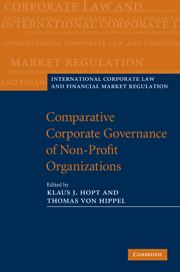Book contents
- Frontmatter
- Contents
- List of contributors
- Preface
- Abbreviations
- PART I Economic findings and theories on nonprofit organizations
- 1 The nonprofit sector: introductory remarks
- 2 Good and not so good governance of nonprofit organizations: factual observations from the USA and Europe
- 2.1 Good and not so good governance of nonprofit organizations: factual observations from the USA
- 2.2 Good and not so good governance of nonprofit organizations: factual observations from foundations in Germany
- 3 Economic theories of nonprofit organizations
- PART II The nonprofit sector: private law, trust law, tax law in selected countries
- PART III The board of nonprofit organizations
- PART IV Good governance of nonprofit organizations: activities and regulatory problems
- PART V Good governance of nonprofit organizations: self-regulation, disclosure and supervision
- Index
- References
2.2 - Good and not so good governance of nonprofit organizations: factual observations from foundations in Germany
from 2 - Good and not so good governance of nonprofit organizations: factual observations from the USA and Europe
Published online by Cambridge University Press: 05 August 2011
- Frontmatter
- Contents
- List of contributors
- Preface
- Abbreviations
- PART I Economic findings and theories on nonprofit organizations
- 1 The nonprofit sector: introductory remarks
- 2 Good and not so good governance of nonprofit organizations: factual observations from the USA and Europe
- 2.1 Good and not so good governance of nonprofit organizations: factual observations from the USA
- 2.2 Good and not so good governance of nonprofit organizations: factual observations from foundations in Germany
- 3 Economic theories of nonprofit organizations
- PART II The nonprofit sector: private law, trust law, tax law in selected countries
- PART III The board of nonprofit organizations
- PART IV Good governance of nonprofit organizations: activities and regulatory problems
- PART V Good governance of nonprofit organizations: self-regulation, disclosure and supervision
- Index
- References
Summary
Introduction
One core area of the nonprofit sector in Germany is the German foundation system. The incorporated foundation, which is regulated in Sections 80–88 of the German Civil Code (BGB), is considered the prototype and legislative model for foundations. This type of foundation accomplishes its charitable purpose only by grant-making. In addition, there are a great number of foundations lacking legal capacity, substitute types such as the foundation company and foundation association, as well as public foundations.
The foundation sector has been growing constantly, with particularly dynamic growth rates starting more than ten years ago. At the beginning of 2007, 14,401 incorporated foundations with legal personality were known to exist in Germany, while in 1995, only half that number existed (7,095); 889 of these foundations were newly founded in 2006. Although the oldest German foundations are probably more than a thousand years old, the majority represents quite a young and varied group of institutions whose contours and self-concept are still developing and undergoing a process of change which has been both promoted by the modernizing legislation of the past several years and frustrated by attempts to liberalize regulations. “Foundation governance” as an instrument for self-regulation and self-validation is the subject of increasing discussion in the industry, which must also be seen in the context of these trends.
- Type
- Chapter
- Information
- Publisher: Cambridge University PressPrint publication year: 2010
References
- 2
- Cited by



